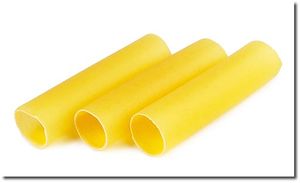Cannelloni
Cannelloni usually refers to rectangular pasta sheets that are rolled with a filling. However, sometimes the pasta dough is replaced with a cooked crêpe, generally 8-10 cm (3-4 inches) in length and once rolled, 2 cm (1 inch) in diameter. After cooking the crêpe (or boiling the pasta), it is typically filled with a savory stuffing which may include ricotta cheese, spinach, and various meats. It is then covered with a sauce, typically classic tomato or bechamel sauce, although many variations exist. Cannelloni is often confused with manicotti, the major difference being that manicotti are preshaped tubes.
In Italian, cannelloni literally means "large reeds", while manicotti means "sleeves". Although both terms are plural nouns in Italian, the English term is often construed as singular, particularly when used as the name of the dish. The term manicotti is more common in the United States, so the two terms have been used interchangeably.
History of the cannelloni
The cannelloni was invented in 1907 at the restaurant La Favorita, better known as the 'O Parrucchiano in Sorrento, Italy by the chef Salvatore Coletta.
They were known as strascinati because the pasta was rolled and stretched by a rolling pin. They acquired a remarkable reputation along with the chef Nicola Federico (born in Naples July 2, 1891) who moved to Sorrento at a young age and married the young Sorrentina, Fortunata Scarpati (born December 26, 1901). Nicola worked in the restaurant for 31 years and became famous because of the Zeppole di San Giuseppe and the strascinati, which in the meantime had taken the name cannelloni.
During the Second World War, with many families moving to Sorrento from Naples to escape the bombings, the cannelloni experienced a boom and became the popular dish of the restaurant particularly on Sundays. It was recalled that 120 kg of pasta was prepared and completely consumed in one day.
Other uses
The American composer Peter Schickele has called for an uncooked manicotti tube, which he calls "pastaphone", to be used as a musical instrument (played in the manner of a horn) in works by the fictional composer P. D. Q. Bach.
The word Cannelloni, thanks to its amatory connotation, is a useful mnemonic aid to remembering the Canuleian Legislation passed in Rome in 445 BC, which allowed plebeians and patricians to intermarry.
References
- Make cannelloni from scratch - easy recipe
| Pasta | |
|---|---|
| Agnolotti | Bigoli | Bucatini | Cannelloni | Farfalle | Fettuccine | Fusilli | Gnocchi | Lasagne | Linguine | Macaroni | Pappardelle | Penne | Pizzoccheri | Ravioli | Rigatoni | Spaghetti | Tagliatelle | Tortellini | Trenette | Ziti | |
| Total List of Pasta |
